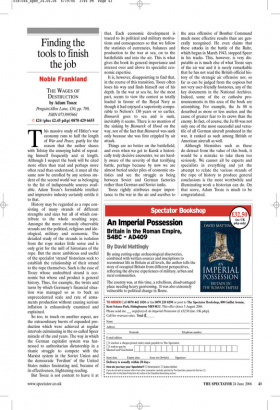Finding the tools to finish the job
Noble Frankland
THE WAGES OF DESTRUCTION by Adam Tooze Penguin/Allen Lane, £30, pp. 799, ISBN 0713995661 ✆ £24 (plus £2.45 p&p) 0870 429 6655 This massive study of Hitler’s war economy runs to half the length of War and Peace, partly for the reason that the author shares with Tolstoy the annoying habit of repeating himself frequently and at length. Although I suspect the book will be cited more often than read and perhaps more often read than understood, it must all the same now be enrolled by any serious student of the second world war as belonging to the list of indispensable sources available. Adam Tooze’s formidable intellect and impressive industry certainly entitle it to that.
History may be regarded as a rope consisting of many strands of different strengths and sizes but all of which contribute to the whole resulting rope. Amongst the more obviously observable strands are the political, religious and ideological, military and economic. The detailed study of the strands in isolation from the rope makes little sense and is only grist for the mill of historians of the rope. But the more ambitious and useful of the specialist ‘strand’ historians seek to establish the relationship of their strand to the rope themselves. Such is the case of Tooze whose undoubted strand is economic but whose end product is general history. Thus, for example, the twists and turns by which Germany’s financial situation was managed so as to back an unprecedented scale and rate of armaments production without causing serious inflation is exhaustively examined and explained.
So too, to touch on another aspect, are the extraordinary bursts of expanded production which were achieved at regular intervals culminating in the so-called Speer miracle of the end years. The way in which the German capitalist system was harnessed to authoritarian dictatorship in a titanic struggle to compete with the Marxist system in the Soviet Union and the democratic ‘Fordism’ of the United States makes fascinating and, because of its effectiveness, frightening reading.
But Tooze is not content to leave it at that. Each economic development is traced to its political and military motivations and consequences so that we follow the statistics of currencies, balances and production to the war at sea, on to the battlefields and into the air. This is what gives the book its general importance and interest over and above its specialist economic expertise.
It is, however, disappointing to find that, in the course of this transition, Tooze often loses his way and finds himself out of his depth. In the war at sea he, for the most part, seems to view the contest as totally loaded in favour of the Royal Navy as though it had enjoyed a superiority comparable to Nelson’s 130 years or so earlier. Bismarck goes to sea and is sunk, inevitably it seems. There is no mention of the sinking by Bismarck of Hood on the way, nor of the fact that Bismarck was sunk only because she was first crippled by air attack.
Things are no better on the battlefield, and even when we get to Kursk a historically truly decisive encounter, we are hardly aware of the severity of that terrifying battle, perhaps because by now we are almost buried under piles of economic statistics and see the struggle as being between Soviet and German factories rather than German and Soviet tanks.
Tooze rightly attributes major importance to the war in the air and ascribes to the area offensive of Bomber Command much more effective results than are generally recognised. He even claims that these attacks in the battle of the Ruhr, which began in March 1943, stopped Speer in his tracks. This, however, is very disputable as is much else of what Tooze says of the air war and it is surely remarkable that he has not read the British official history of the strategic air offensive nor, so far as can be judged from the copious but not very user-friendly footnotes, any of the key documents in the National Archives. Indeed, some of the ex cathedra pronouncements in this area of the book are astonishing. For example, the Ju 88 is described as more or less useless and the cause of greater fear to its crews than the enemy. In fact, of course, the Ju 88 was not only one of the most successful and versatile of all German aircraft produced in the war, it ranked as such among British or American aircraft as well.
Although blemishes such as these do detract from the value of this book, it would be a mistake to take them too seriously. We cannot all be experts and specialists in everything and yet the attempt to relate the various strands of the rope of history to produce general conclusions is the most worthwhile and illuminating work a historian can do. On that score, Adam Tooze is much to be congratulated.



















































 Previous page
Previous page